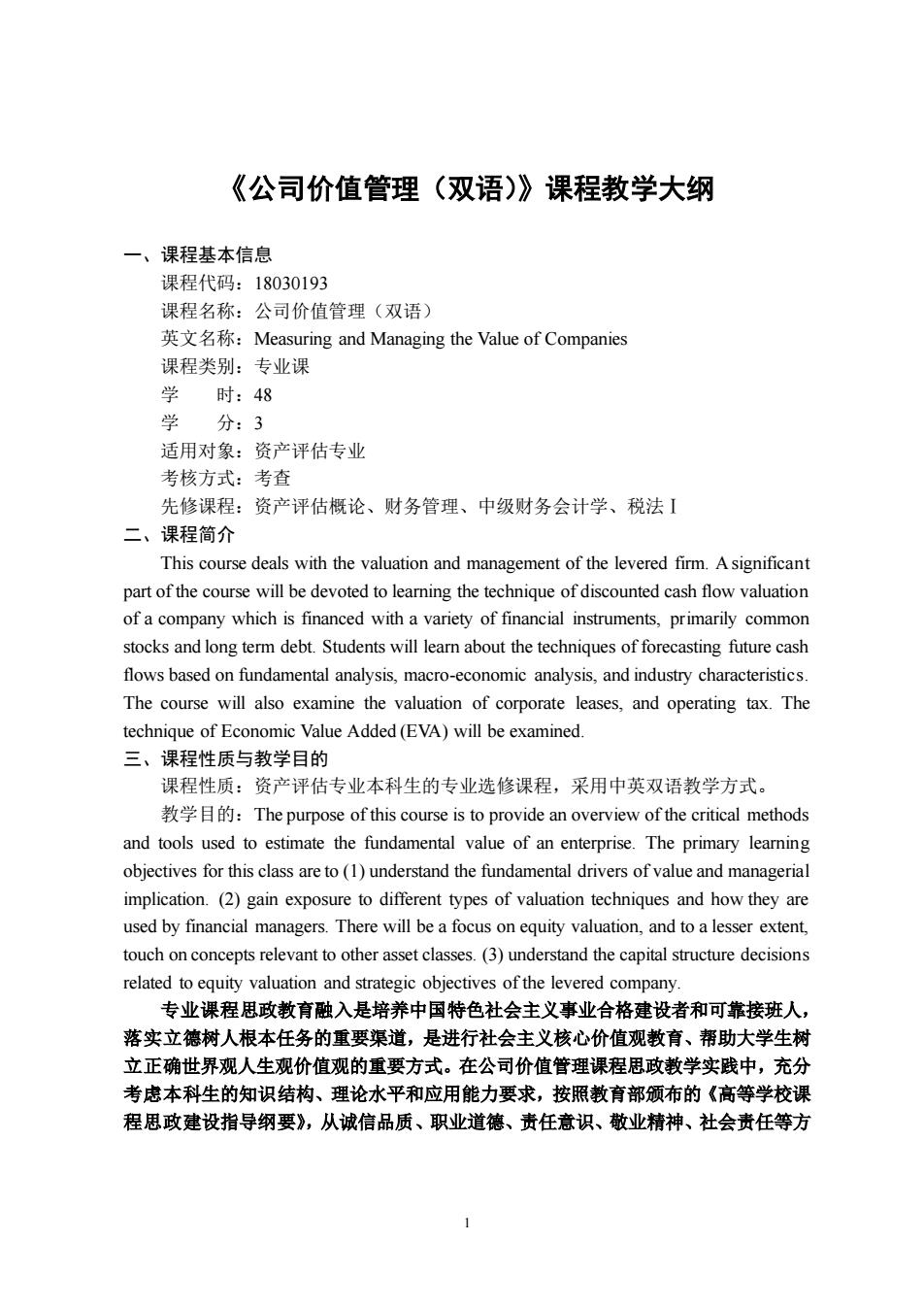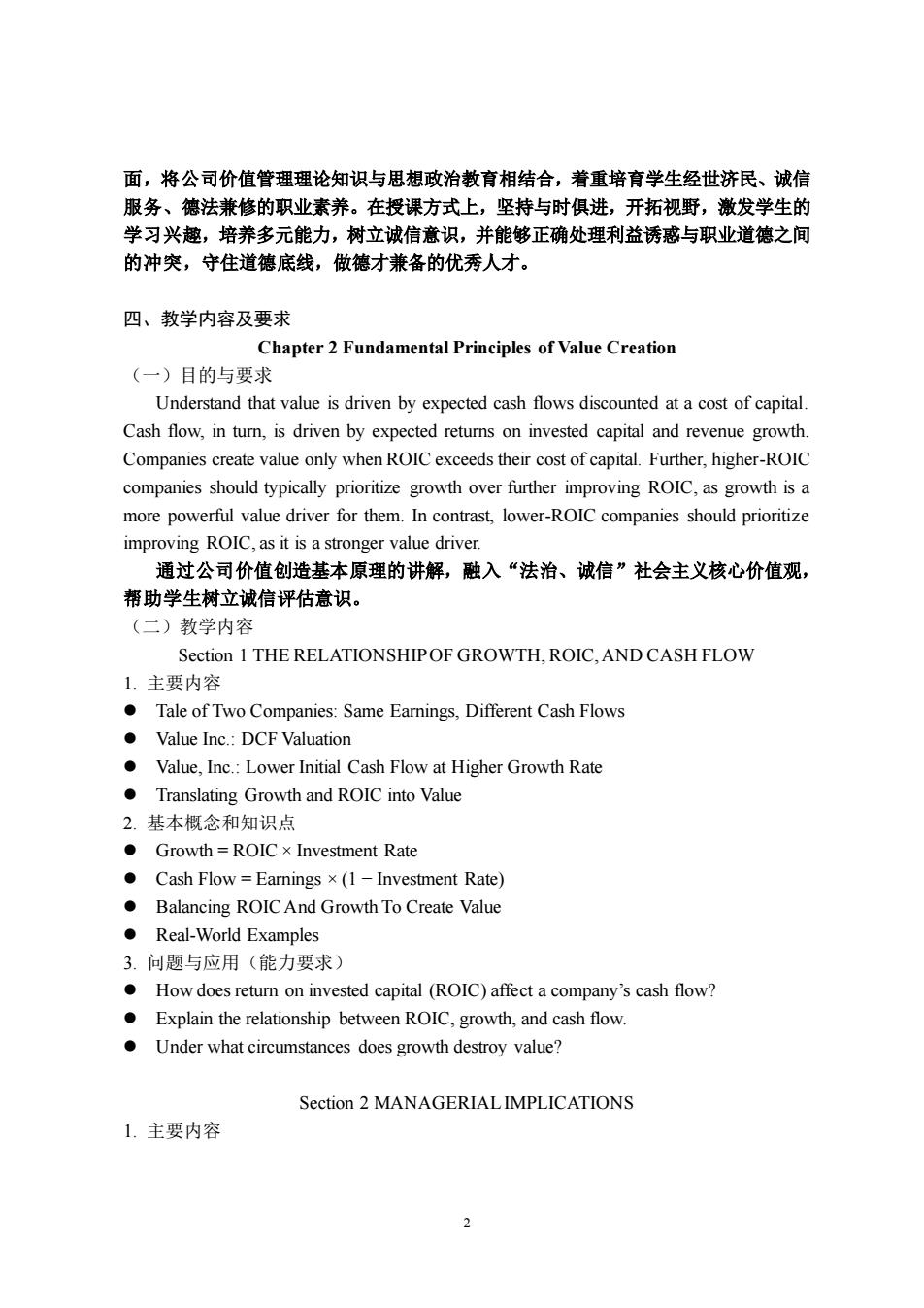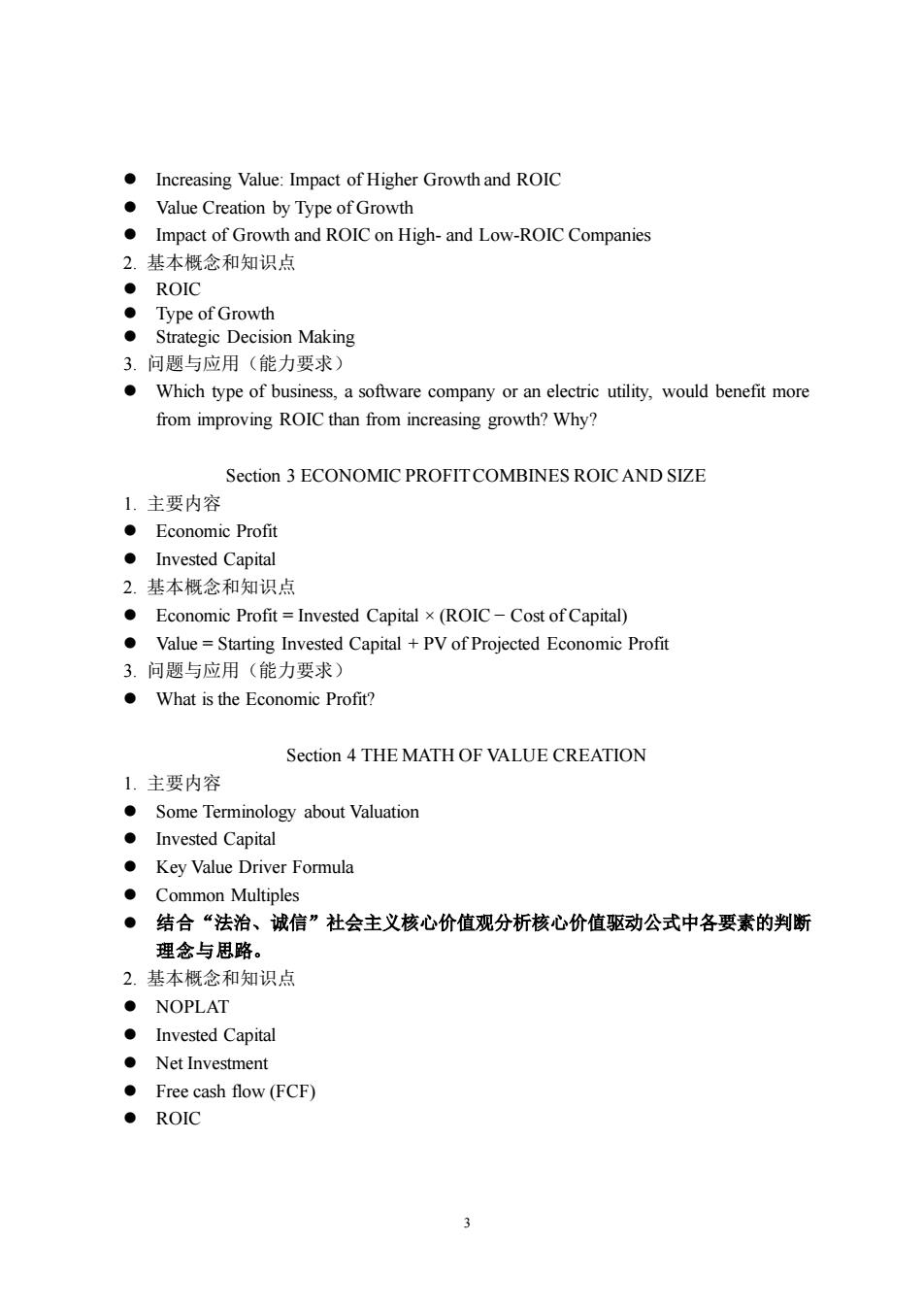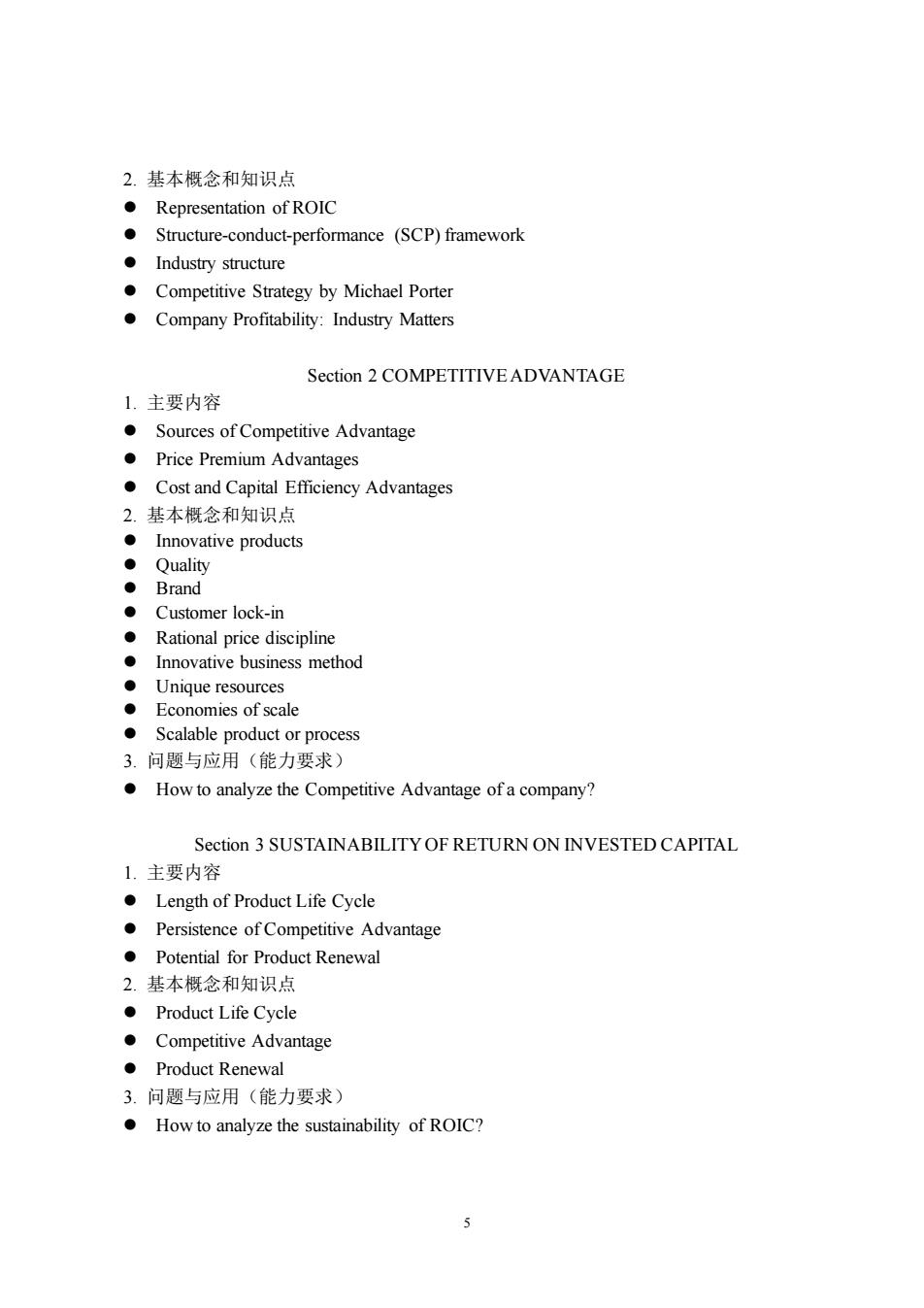
《公司价值管理(双语)》课程教学大纲 一、课程基本信息 课程代码:18030193 课程名称:公司价值管理(双语) 英文名称:Measuring and Managing the Value of Companies 课程类别:专业课 时:48 学 分分:3 适用对象:资产评估专业 老核方式:老查 先修课程:资产评估概论、财务管理、中级财务会计学、税法 二、课程简介 This course deals with the valuation and management of the levered firm.Asignificant part of the course will be devoted to leaming the technique of discounted cash flow valuation of a company which is financed with a variety of financial instruments,primarily common stocks and long term debt.Students will leamn about the techniques of forecasting future cash flows based on fundamental analysis,macro-economic analysis,and industry characteristics. The course will also examine the valuation of corporate leases,and operating tax.The technique of Economic Value Added (EVA)will be examined 三、课程性质与教学目的 课程性质:资产评估专业本科生的专业选修课程,采用中英双语教学方式。 教学目的:The purpose of this course is to provide an overview of the critical methods and tools used to estimate the fundamental value of an enterprise.The primary learning objectives for this class are to(1)understand the fundamental drivers of value and managerial implication.(2)gain exposure to different types of valuation techniques and how they are used by financial managers.There will be a focus onequity valuation,and to a lesser extent touch on concepts relevant to other asset classes.(3)understand the capital structure decisions related and strategic objectives of the levered company 专业课程思政教育融入是培养中国特色社会主义事业合格建设者和可靠接班人, 落实立德树人根本任务的重要渠道,是进行社会主义核心价值观教育、帮助大学生树 立正确世界观人生观价值观的重要方式。在公司价值管理课程思政教学实践中,充分 考虑本科生的知识结构、理论水平和应用能力要求,按照教有部颁布的《高等学校课 程思政建设指导纲要》,从诚信品质、职业道德、责任意识、敬业精神、社会责任等方 1
1 《公司价值管理(双语)》课程教学大纲 一、课程基本信息 课程代码:18030193 课程名称:公司价值管理(双语) 英文名称:Measuring and Managing the Value of Companies 课程类别:专业课 学 时:48 学 分:3 适用对象:资产评估专业 考核方式:考查 先修课程:资产评估概论、财务管理、中级财务会计学、税法Ⅰ 二、课程简介 This course deals with the valuation and management of the levered firm. A significant part of the course will be devoted to learning the technique of discounted cash flow valuation of a company which is financed with a variety of financial instruments, primarily common stocks and long term debt. Students will learn about the techniques of forecasting future cash flows based on fundamental analysis, macro-economic analysis, and industry characteristics. The course will also examine the valuation of corporate leases, and operating tax. The technique of Economic Value Added (EVA) will be examined. 三、课程性质与教学目的 课程性质:资产评估专业本科生的专业选修课程,采用中英双语教学方式。 教学目的:The purpose of this course is to provide an overview of the critical methods and tools used to estimate the fundamental value of an enterprise. The primary learning objectives for this class are to (1) understand the fundamental drivers of value and managerial implication. (2) gain exposure to different types of valuation techniques and how they are used by financial managers. There will be a focus on equity valuation, and to a lesser extent, touch on concepts relevant to other asset classes. (3) understand the capital structure decisions related to equity valuation and strategic objectives of the levered company. 专业课程思政教育融入是培养中国特色社会主义事业合格建设者和可靠接班人, 落实立德树人根本任务的重要渠道,是进行社会主义核心价值观教育、帮助大学生树 立正确世界观人生观价值观的重要方式。在公司价值管理课程思政教学实践中,充分 考虑本科生的知识结构、理论水平和应用能力要求,按照教育部颁布的《高等学校课 程思政建设指导纲要》,从诚信品质、职业道德、责任意识、敬业精神、社会责任等方

面,将公司价值管理理论知识与思想政治教育相结合,着重培育学生经世济民、诚信 服务、德法兼修的职业素养。在授课方式上,坚持与时俱进,开拓视野,激发学生的 学习兴趣,培养多元能力,树立诚信意识,并能够正确处理利益诱感与职业道德之间 的冲突,守住道德底线,做德才兼备的优秀人才。 四、教学内容及要求 Chapter 2 Fundamental Principles of Value Creation (一)目的与要求 Understand that value is driven by expected cash flows discounted at a cost of capital. Cash flow,in tum,is driven by expected returns on invested capital and revenue growth. Companies create value only when ROIC exceeds their cost of capital Further,higher-ROIC companies should typically prioritize growth over further improving ROIC,as growth is a more powerful value driver for them.In contrast,lower-ROIC companies should prioritize improving ROIC.as it is a stronger value driver. 通过公司价值创造基本原理的讲解,融入“法治、诚信”社会主义核心价值观, 帮助学生树立诚信评估意识。 (二)教学内容 Section I THE RELATIONSHIPOF GROWTH,ROIC,AND CASH FLOW 1.主要内容 Tale of Two Companies:Same Earnings,Different Cash Flows Value Ine.:DCF Valuation Value,Inc.:Lower Initial Cash Flow at Higher Growth Rate Translating Growth and ROIC into Value 2.基本概念和知识点 ●Growth=ROIC×Investment Rate ●Cash Flow=Earnings×(I-Investment Rate) Balancing ROICAnd Growth To Create Value ●Real-Vorld Examples 3.问题与应用(能力要求) How does retum on invested capital(ROIC)affect a company's cash flow? Explain the relationship between ROIC,growth,and cash flow. Under what circumstances does growth destroy value? Section 2 MANAGERIAL IMPLICATIONS 1.主要内容 2
2 面,将公司价值管理理论知识与思想政治教育相结合,着重培育学生经世济民、诚信 服务、德法兼修的职业素养。在授课方式上,坚持与时俱进,开拓视野,激发学生的 学习兴趣,培养多元能力,树立诚信意识,并能够正确处理利益诱惑与职业道德之间 的冲突,守住道德底线,做德才兼备的优秀人才。 四、教学内容及要求 Chapter 2 Fundamental Principles of Value Creation (一)目的与要求 Understand that value is driven by expected cash flows discounted at a cost of capital. Cash flow, in turn, is driven by expected returns on invested capital and revenue growth. Companies create value only when ROIC exceeds their cost of capital. Further, higher-ROIC companies should typically prioritize growth over further improving ROIC, as growth is a more powerful value driver for them. In contrast, lower-ROIC companies should prioritize improving ROIC, as it is a stronger value driver. 通过公司价值创造基本原理的讲解,融入“法治、诚信”社会主义核心价值观, 帮助学生树立诚信评估意识。 (二)教学内容 Section 1 THE RELATIONSHIP OF GROWTH, ROIC, AND CASH FLOW 1. 主要内容 ⚫ Tale of Two Companies: Same Earnings, Different Cash Flows ⚫ Value Inc.: DCF Valuation ⚫ Value, Inc.: Lower Initial Cash Flow at Higher Growth Rate ⚫ Translating Growth and ROIC into Value 2. 基本概念和知识点 ⚫ Growth = ROIC × Investment Rate ⚫ Cash Flow = Earnings × (1 − Investment Rate) ⚫ Balancing ROIC And Growth To Create Value ⚫ Real-World Examples 3. 问题与应用(能力要求) ⚫ How does return on invested capital (ROIC) affect a company’s cash flow? ⚫ Explain the relationship between ROIC, growth, and cash flow. ⚫ Under what circumstances does growth destroy value? Section 2 MANAGERIAL IMPLICATIONS 1. 主要内容

Increasing Value:Impact of Higher Growth and ROIC Value Creation by Type of Growth Impact of Growth and ROIC on High-and Low-ROIC Companies 2.基本概念和知识点 ●ROIC ●Type of Growth Strategic Decision Making 3.问题与应用(能力要求) Which type of business,a software company or an electric utility,would benefit more from improving ROIC than from increasing growth?Why? Section 3 ECONOMIC PROFITCOMBINES ROIC AND SIZE 1.主要内容 ●Economic Profit ●Invested Capital 2.基本概念和知识点 Economic Profit=Invested Capital x(ROIC-Cost of Capital) Value =Starting Invested Capital +PV of Projected Economic Profit 3.问题与应用(能力要求) What is the Economic Profit? Section 4 THE MATH OF VALUE CREATION 1.主要内容 Some Terminology about Valuation ●Invested Capita Key Value Driver Formula ●Common Multiples ·结合“法治、诚信”社会主义核心价值观分析核心价值驱动公式中各要素的判断 理念与思路。 2.基本概念和知识点 ·NOPLAT ●Invested Capital ●Net Investment ●Free cash flow(FCF) ROIC 3
3 ⚫ Increasing Value: Impact of Higher Growth and ROIC ⚫ Value Creation by Type of Growth ⚫ Impact of Growth and ROIC on High- and Low-ROIC Companies 2. 基本概念和知识点 ⚫ ROIC ⚫ Type of Growth ⚫ Strategic Decision Making 3. 问题与应用(能力要求) ⚫ Which type of business, a software company or an electric utility, would benefit more from improving ROIC than from increasing growth? Why? Section 3 ECONOMIC PROFIT COMBINES ROIC AND SIZE 1. 主要内容 ⚫ Economic Profit ⚫ Invested Capital 2. 基本概念和知识点 ⚫ Economic Profit = Invested Capital × (ROIC − Cost of Capital) ⚫ Value = Starting Invested Capital + PV of Projected Economic Profit 3. 问题与应用(能力要求) ⚫ What is the Economic Profit? Section 4 THE MATH OF VALUE CREATION 1. 主要内容 ⚫ Some Terminology about Valuation ⚫ Invested Capital ⚫ Key Value Driver Formula ⚫ Common Multiples ⚫ 结合“法治、诚信”社会主义核心价值观分析核心价值驱动公式中各要素的判断 理念与思路。 2. 基本概念和知识点 ⚫ NOPLAT ⚫ Invested Capital ⚫ Net Investment ⚫ Free cash flow (FCF) ⚫ ROIC

●R ·WACC ●Growth 3.问题与应用(能力要求) How to explain the key value driver formula? (三)思若与实 1.If value is based on discounted cash flows,why should a company or investor analyze growth and ROIC? 2.结合“法治”和“诚信”这两方面的社会主义核心价值观,思考如何避免“价值创 造与评估”沦为“数字游戏”。 (四)数学方法与手段 Lecture,Multimedia Teaching,and Class Discussion. Chapter 6 Return on Invested Capital (一)目的与要求 There are many lessons to leamn about returns on invested capital.First,these returns are driven by competitive advantages that enable companies to realize price premiums,cost and capital efficiencies.or some combination of these.Second,industry structure is an important but not an exclusive determinant of ROIC.Certain industries are more likely to eam either high.medium.or low returns.but there is still significant variation in the rates of return for individual companies within each industry.Third,and most important,if a company finds a formula or strategy that eams an attractive ROIC.there is a good chance it can sustain that attractive retumn over time and through changing economic,industry,and company conditions-especially in the case of industries that enjoy relatively long product life cycles Unfortunately,the converse is also true:if a company eams a low ROIC,that is likely to persist as well (二)教学内容 Section 1 WHAT DRIVES ROIC 1.主要内容 Understand how strategy,competitive advantage.and retum on invested capital are linked. The importance of industry structure to ROIC Competitive behavior 4
4 ⚫ IR ⚫ WACC ⚫ Growth 3. 问题与应用(能力要求) ⚫ How to explain the Key Value Driver Formula? (三)思考与实践 1. If value is based on discounted cash flows, why should a company or investor analyze growth and ROIC? 2. 结合“法治”和“诚信”这两方面的社会主义核心价值观,思考如何避免“价值创 造与评估”沦为“数字游戏”。 (四)教学方法与手段 Lecture, Multimedia Teaching, and Class Discussion. Chapter 6 Return on Invested Capital (一)目的与要求 There are many lessons to learn about returns on invested capital. First, these returns are driven by competitive advantages that enable companies to realize price premiums, cost and capital efficiencies, or some combination of these. Second, industry structure is an important but not an exclusive determinant of ROIC. Certain industries are more likely to earn either high, medium, or low returns, but there is still significant variation in the rates of return for individual companies within each industry. Third, and most important, if a company finds a formula or strategy that earns an attractive ROIC, there is a good chance it can sustain that attractive return over time and through changing economic, industry, and company conditions—especially in the case of industries that enjoy relatively long product life cycles. Unfortunately, the converse is also true: if a company earns a low ROIC, that is likely to persist as well. (二)教学内容 Section 1 WHAT DRIVES ROIC 1. 主要内容 ⚫ Understand how strategy, competitive advantage, and return on invested capital are linked. ⚫ The importance of industry structure to ROIC ⚫ Competitive behavior

2.基本概念和知识点 Representation of ROIC Structure-conduct-performance (SCP)framework ●Industry structure Competitive Strategy by Michael Porter Company Profitability:Industry Matters Section 2 COMPETITIVEADVANTAGE 1.主要内容 Sources of Competitive Advantage Price Premium Advantages Cost and Capital Efficiency Advantages 2.基本概念和知识点 Innovative products ●Quality ●Brand ●Customer lock-inm Rational price discipline Innovative business method Unique resources ● Economies of scale Scalable product or process 3.问题与应用(能力要求) How to analyze the Competitive Advantage of a company? Section 3 SUSTAINABILITY OF RETURN ON INVESTED CAPITAL 1.主要内容 Length of Product Life Cycle Persistence of Competitive Advantage Potential for Product Renewal 2.基本概念和知识点 ●Product Life Cycle Competitive Advantage ●Product Renewal 3.问题与应用(能力要求) How to analyze the sustainability of ROIC? 5
5 2. 基本概念和知识点 ⚫ Representation of ROIC ⚫ Structure-conduct-performance (SCP) framework ⚫ Industry structure ⚫ Competitive Strategy by Michael Porter ⚫ Company Profitability: Industry Matters Section 2 COMPETITIVE ADVANTAGE 1. 主要内容 ⚫ Sources of Competitive Advantage ⚫ Price Premium Advantages ⚫ Cost and Capital Efficiency Advantages 2. 基本概念和知识点 ⚫ Innovative products ⚫ Quality ⚫ Brand ⚫ Customer lock-in ⚫ Rational price discipline ⚫ Innovative business method ⚫ Unique resources ⚫ Economies of scale ⚫ Scalable product or process 3. 问题与应用(能力要求) ⚫ How to analyze the Competitive Advantage of a company? Section 3 SUSTAINABILITY OF RETURN ON INVESTED CAPITAL 1. 主要内容 ⚫ Length of Product Life Cycle ⚫ Persistence of Competitive Advantage ⚫ Potential for Product Renewal 2. 基本概念和知识点 ⚫ Product Life Cycle ⚫ Competitive Advantage ⚫ Product Renewal 3. 问题与应用(能力要求) ⚫ How to analyze the sustainability of ROIC?